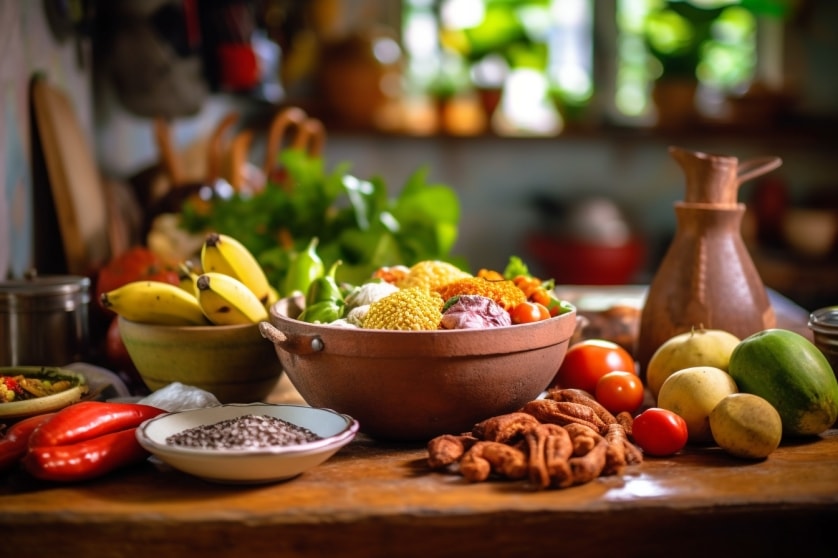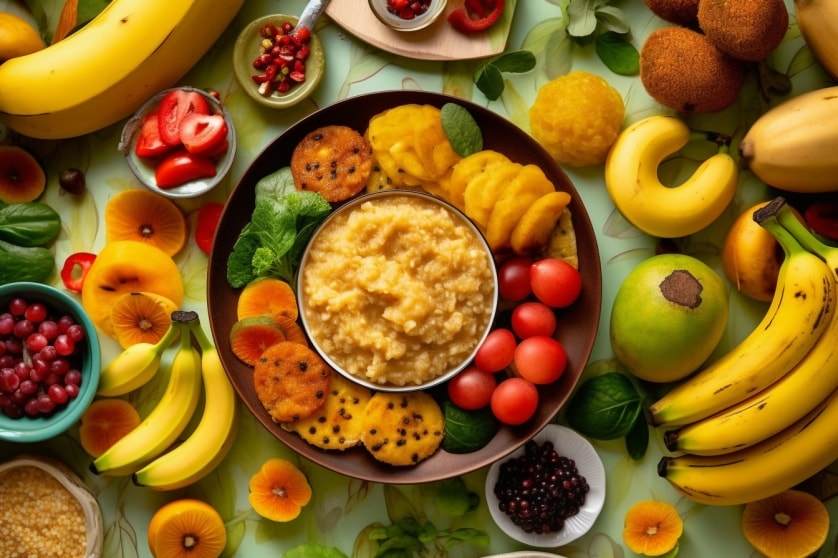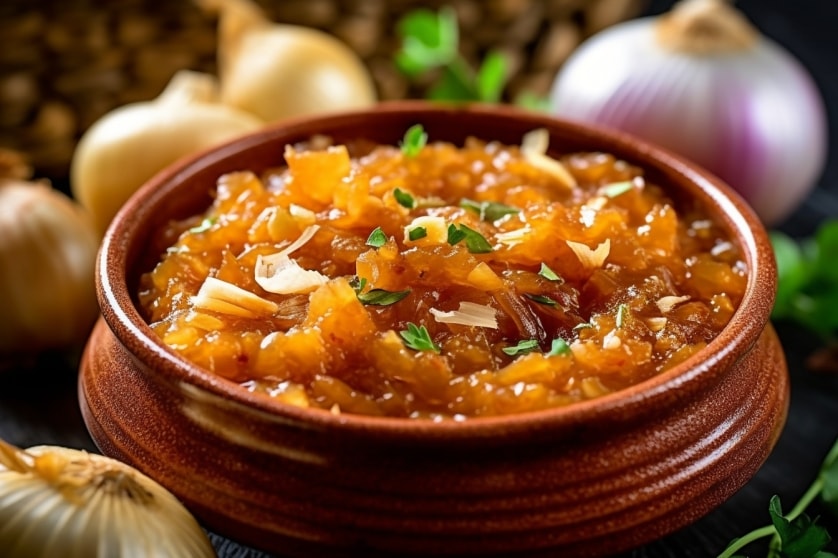Table of Contents
ToggleDominican Mangu for Babies: A Mashed Plantain Dish with Onion Sauce
Introduction:
Oh, baby, do I have a treat for you! Get ready to embark on a flavorful journey to the Caribbean, where vibrant colors, lively music, and mouthwatering aromas dance together to create a culinary paradise. As a successful woman family care blogger and author with a Caribbean background, I’m here to sprinkle a dash of Caribbean magic into your baby’s diet. And today, we’re diving deep into the heart and soul of Dominican cuisine with a dish that will make your little one’s taste buds tango with joy: Dominican Mangu!
Now, picture this: golden plantains, perfectly ripe and exuding a tropical sweetness, transformed into a creamy mash that melts in your baby’s mouth like a gentle island breeze. But we’re not stopping there. Oh, no! We’re topping it off with a tantalizing onion sauce that adds a burst of savory flavors and a touch of Caribbean flair. Trust me, this dish is a celebration on a plate, and your baby is about to become the guest of honor.
Food is not just nourishment; it’s an adventure, a journey that connects us to our roots and helps us discover new horizons. By introducing your little one to the flavors and traditions of the Caribbean, you’re opening a world of possibilities. Imagine the joy of watching your baby’s eyes widen in delight as they experience the vibrant colors, enticing aromas, and bold flavors of Dominican Mangu. It’s a passport to a world of tastes, textures, and cultural connections.
Caribbean cuisine, with its fusion of African, Spanish, and indigenous influences, is a treasure trove of culinary wonders. And at the heart of it all, you’ll find Mangu—a beloved dish in Dominican households. But why settle for plain and predictable when you can introduce your baby to an explosion of flavors and a touch of Caribbean sunshine?
So, fasten your seatbelts, my fellow food adventurers, because we’re about to embark on a gastronomic escapade. We’ll uncover the secrets of Dominican Mangu, savor its rich history, explore its nutritional benefits, and equip you with all the tips and tricks you need to create a baby-friendly version of this Caribbean masterpiece. Get ready to take your baby’s taste buds on a salsa dance with Dominican Mangu for babies!

Section 1: Exploring Dominican Cuisine
Welcome to the vibrant world of Dominican cuisine, where flavors collide, and taste buds ignite with joy! If you’re ready to embark on a culinary adventure that will have your baby doing the merengue in their high chair, then you’ve come to the right place. Dominican cuisine is a captivating fusion of flavors influenced by African, Spanish, and indigenous traditions. Get ready to tantalize your taste buds and uncover the secrets behind the mouthwatering dishes that make the Dominican Republic a true food lover’s paradise.
Imagine strolling through the bustling streets of Santo Domingo, the capital city of the Dominican Republic, with its colorful markets overflowing with fresh produce. The air is infused with the irresistible aromas of spices, tropical fruits, and sizzling street food. It’s a sensory symphony that beckons you to explore the culinary treasures hidden within this Caribbean gem.
At the heart of Dominican cuisine lies an ingredient that steals the spotlight—plantains. These humble, versatile fruits are the foundation of many beloved dishes, including our star of the show, Mangu. Plantains are the Caribbean’s version of a culinary chameleon—they can be boiled, fried, baked, or mashed, taking on different flavors and textures depending on how they’re prepared.
But it’s not just plantains that define Dominican cuisine. Picture yourself savoring a plate of sancocho, a hearty stew that warms the soul with its rich blend of meats, vegetables, and spices. Or indulge in a mouthwatering plate of chicharrón, crispy pork belly that crackles with flavor. And let’s not forget about the national dish, la bandera dominicana, which translates to the Dominican flag. This patriotic culinary masterpiece consists of rice, beans, and meat, beautifully representing the colors of the Dominican flag.
One fascinating aspect of Dominican cuisine is the strong African influence, brought by the enslaved Africans who were an integral part of the country’s history. African flavors and cooking techniques intertwine with indigenous ingredients, creating a culinary tapestry that tells a story of resilience and cultural diversity.
As you explore Dominican cuisine, you’ll encounter ingredients that bring bursts of flavor to every bite. Spices such as garlic, oregano, cilantro, and the beloved Dominican oregano, known as recao, infuse dishes with aromatic magic. Tropical fruits like mangoes, guavas, and passion fruit add a refreshing sweetness to balance the savory notes.
But Dominican cuisine is not just about the ingredients; it’s about the passion and love that goes into every dish. The Dominican people take immense pride in their culinary heritage, and cooking is a language of love that brings families together. From the clinking of pots and pans in bustling kitchens to the laughter and chatter around the dining table, Dominican cuisine is a celebration of community, culture, and connection.
So, get ready to immerse yourself in the flavors of the Dominican Republic and embrace the richness of its cuisine. In the following sections, we’ll delve deeper into the captivating history and traditions surrounding Mangu, a dish that captures the essence of Dominican gastronomy. It’s time to unleash your inner food adventurer and embark on a delicious journey that will have your baby craving seconds!

Section 2: Why Choose Mangu for Your Baby?
Now, you may be wondering, why should you choose Mangu for your precious little one? Well, hold onto your baby spoons, because I’m about to reveal the mouthwatering reasons that will make you shout, Mangu for the win!
First and foremost, Mangu is a nutritional powerhouse that will fuel your baby’s growth and development like a Caribbean breeze. It’s packed with essential vitamins and minerals that are vital for your little one’s well-being. The star of the show, plantains, are a fantastic source of dietary fiber, providing gentle support for your baby’s digestion and promoting a healthy gut. And we all know that a happy tummy equals a happy baby!
But that’s not all, folks. Mangu also boasts an impressive lineup of vitamins, including vitamin C, vitamin A, and vitamin B6. These vitamins play a crucial role in supporting your baby’s immune system, vision development, and overall growth. It’s like a superhero cape for your baby’s health!
Now, let’s talk about energy—something your little bundle of joy never seems to run out of. Mangu is here to save the day! This delightful dish provides a natural source of carbohydrates, giving your baby the fuel they need to conquer their day of endless adventures. Whether it’s crawling, exploring new toys, or babbling away, Mangu will keep your baby’s energy levels soaring.
But it’s not just about the nutrition, my dear friends. Mangu offers something even more valuable—it’s an introduction to a world of flavors and textures. Babies are like little food explorers, and it’s essential to nurture their adventurous palates from the start. By introducing Mangu, you’re not only exposing your baby to a unique Caribbean dish but also opening the door to a lifetime of culinary curiosity.
Research has shown that early exposure to diverse flavors can lead to a more varied and accepting palate later in life. So, why not give your baby a head start on their flavor journey? Mangu’s mild and creamy texture, combined with the savory notes of the onion sauce, will tickle your baby’s taste buds and leave them craving more exciting flavors in the future.
But let’s not forget about the cultural aspect. Food is a language that carries stories, traditions, and connections. By introducing Mangu to your baby, you’re immersing them in the vibrant tapestry of Dominican culture. You’re passing down the love and heritage of generations who have savored this dish with laughter and joy. It’s a beautiful way to honor your Caribbean roots and create lasting memories with your little one.
So, my fellow food enthusiasts, let’s raise our baby spoons high and toast to the wonders of Mangu. It’s a dish that not only nourishes your baby’s body but also nourishes their soul. With its nutritional benefits, flavor exploration, and cultural significance, Mangu is the ultimate culinary adventure for your baby. Get ready to embark on a flavor-filled journey that will leave your little one craving seconds and begging for a taste of the Caribbean with every meal!

Section 3: Preparing Mangu for Your Little One
Get ready to put on your chef hat, because it’s time to dive into the wonderful world of preparing Mangu for your little munchkin. Don’t worry—I’ve got all the tips and tricks to ensure your baby’s Mangu experience is nothing short of perfection. So, grab those ripe plantains and let’s get mashing!
First things first, my dear food adventurers: selecting the right plantains is key. You want them to be perfectly ripe—neither too green nor too blackened. Aim for plantains with yellow skins and a few brown spots. This sweet spot ensures that the plantains have reached their peak flavor and will mash up beautifully into a creamy delight.
Now, let’s talk about cooking methods. Traditionally, Mangu is made by boiling the plantains until they are tender and ready to be transformed into a velvety mash. But hey, we love options, right? If boiling isn’t your jam, you can also opt for steaming or baking the plantains. Each method brings a slightly different flavor profile and texture, so feel free to choose the one that tickles your baby’s taste buds.
Once your plantains are cooked to perfection, it’s time to put those muscles to work and get mashing. Grab a sturdy fork or a potato masher and give those plantains a good mashing until you achieve a smooth and lump-free consistency. Remember, we want our Mangu to be silky and easy to digest for those little tummies.
Now, here’s a pro tip for you: if you want to take your baby’s Mangu game to the next level, consider adding a touch of breast milk, formula, or even a splash of vegetable or bone broth while mashing. This not only adds extra creaminess but also introduces familiar flavors that your baby will love. It’s like a secret ingredient that takes Mangu to superstar status!
But wait, we can’t forget about the onion sauce—the crown jewel of Mangu. This savory, aromatic sauce elevates the dish to new heights. To make the perfect onion sauce, start by sautéing some onions in a little oil until they turn soft and golden brown. The caramelized onions will release their sweet and savory flavors, infusing the sauce with a delightful depth of taste.
For an extra burst of flavor, you can add a pinch of garlic, a sprinkle of oregano, or even a squeeze of lime juice to your onion sauce. Feel free to get creative and adjust the seasonings to suit your baby’s palate. Remember, this is all about tailoring the dish to your little one’s taste preferences.
And there you have it—your baby’s very own Mangu masterpiece. Serve the creamy plantain mash on a plate, drizzle it generously with the aromatic onion sauce, and watch your little food explorer’s eyes light up with excitement. This dish is not only a feast for the taste buds but also a celebration of the Caribbean flavors and traditions that will nourish your baby’s body and soul.
So, my fellow culinary adventurers, go forth and conquer the kitchen with confidence. With a little bit of love, a sprinkle of creativity, and a whole lot of mashed plantains, you’ll create a Mangu experience that will make your baby’s taste buds sing with joy. Get ready to savor the flavors of the Caribbean and witness your little one’s love affair with Mangu unfold—one delicious spoonful at a time!

Section 4: Onion Sauce: A Flavorful Addition
Hold onto your taste buds, my fellow food enthusiasts, because we’re about to delve into the world of onion sauce—a magical elixir that transforms Mangu into a flavor sensation like no other. Get ready to tantalize your baby’s taste buds and embark on a culinary adventure that will have them begging for more!
Onion sauce, my dear friends, is the pièce de résistance of Mangu. It’s the secret ingredient that elevates this dish from good to unforgettable. Picture this: sweet and caramelized onions dancing in a symphony of flavors, mingling with savory spices and infusing the air with their tantalizing aroma. It’s a sauce that takes your baby’s taste buds on a roller coaster ride of delight!
So, how do we create this flavorful masterpiece? It all starts with the humble onion. Choose a sweet variety, like the Vidalia or the Walla Walla, that will bring a natural sweetness to the sauce. These onions have a milder flavor, making them perfect for introducing new tastes to your little one.
To begin, slice your onions into thin, delicate rings that will cook down into a luscious caramelized goodness. Heat a drizzle of oil in a pan and sauté those onion rings until they turn soft and golden brown. As they cook, they release their natural sugars, creating a delightful balance of sweet and savory flavors.
Now, let’s add a sprinkle of magic to our onion sauce. This is where you can get creative and tailor the flavors to suit your baby’s palate. For a touch of aromatic wonder, add a pinch of garlic to the pan. The fragrance will fill your kitchen and have your baby eagerly awaiting their Mangu feast.
But we don’t stop there, my culinary explorers. Let’s sprinkle in some oregano, a herb that brings a hint of earthiness and a touch of Mediterranean charm to the sauce. And if you’re feeling adventurous, a squeeze of lime juice adds a bright, tangy note that balances out the sweetness of the onions.
Now, as the onions continue to dance in the pan, absorbing all those flavors, you’ll notice the kitchen transforming into a haven of tantalizing scents. It’s like a Caribbean party in your very own home, and your baby is the guest of honor!
Once your onions have reached their golden glory, it’s time to unite them with the star of the show—Mangu. Drizzle that flavorful onion sauce generously over the creamy plantain mash, letting the flavors meld together in a symphony of taste. Every bite will transport your baby to the sun-soaked shores of the Dominican Republic, where laughter, love, and good food abound.
But here’s a little secret, my dear friends. Onion sauce isn’t just for Mangu—it’s a versatile condiment that can jazz up any dish. Use it as a dipping sauce for grilled meats or roasted vegetables. Slather it on sandwiches for a burst of flavor. The possibilities are endless, and your baby’s taste buds will thank you for the culinary adventure!
So, my fellow flavor enthusiasts, it’s time to embrace the power of onion sauce and unlock a world of taste for your little one. With its sweet, caramelized onions, fragrant spices, and a touch of tang, this sauce is the key to turning ordinary Mangu into an extraordinary culinary masterpiece. Get ready to savor each delectable spoonful and witness the joy that only the perfect combination of flavors can bring to your baby’s culinary journey!

Section 5: Ingredients and Recipe Steps
Are you ready to embark on a culinary adventure and whip up a delectable batch of Mangu for your little one? Grab your apron, sharpen those knives, and let’s dive into the exciting world of ingredients and recipe steps. Get ready to create a mouthwatering masterpiece that will have your baby’s taste buds dancing with joy!
Ingredients:
- 2 ripe plantains
- 1 tablespoon of oil (olive oil or coconut oil works great!)
- 1 medium-sized onion
- 1 clove of garlic (optional, for extra flavor)
- A pinch of dried oregano
- A squeeze of fresh lime juice (optional, for a zesty kick)
- A sprinkle of love and culinary creativity!
Recipe Steps:
- Start by selecting two ripe plantains. Look for ones with yellow skins and a few brown spots—these are the perfect balance of sweet and flavorful. Peel the plantains and slice them into chunks, about an inch thick.
- Bring a pot of water to a boil and add the plantain chunks. Boil them for about 10-15 minutes or until they become tender and easily mashable with a fork. Drain the plantains and set them aside.
- While the plantains are cooking, let’s move on to the onion sauce. Chop the onion into thin slices and mince the garlic, if using. Heat a tablespoon of oil in a pan over medium heat. Add the onions and sauté them until they turn soft and golden brown. This process may take around 8-10 minutes, so be patient—the caramelization is worth it!
- If you’re using garlic, add it to the pan and cook for another minute or so until fragrant. Then, sprinkle in the dried oregano and give it a quick stir. The aroma will fill your kitchen, and your taste buds will rejoice in anticipation!
- Now, it’s time to mash those plantains. Grab a fork or a potato masher and start mashing until you achieve a smooth and creamy consistency. If you want to add an extra touch of creaminess, you can incorporate a splash of breast milk, formula, or even a little vegetable or bone broth while mashing. It’s a secret ingredient that will take your Mangu to the next level!
- Once the plantains are mashed to perfection, it’s time to bring everything together. Plate the creamy Mangu and generously drizzle it with the tantalizing onion sauce. If you’re feeling adventurous, squeeze a bit of fresh lime juice over the top for a burst of zesty goodness.
- And there you have it—your very own homemade Mangu masterpiece! Serve it up to your little one and watch their eyes light up with delight as they take their first bite of this Caribbean delight. Don’t forget to snap a cute photo for the baby album!
Remember, my fellow culinary adventurers, cooking is an art, and these steps are merely a guideline. Feel free to add your personal touch, adjust the seasonings, and experiment with different flavors. Cooking is a journey of discovery, and with Mangu as your compass, you’ll create cherished memories and nourish your baby’s palate along the way.
So, put on that chef hat, gather your ingredients, and let the Mangu-making extravaganza begin! May your kitchen be filled with laughter, delicious aromas, and the joy of watching your little one savor the flavors of the Caribbean. Happy cooking!
Conclusion
Congratulations, my culinary comrades! You have successfully embarked on a flavor-filled journey through the vibrant world of Dominican cuisine and introduced your little one to the wonders of Mangu—a mashed plantain dish with tantalizing onion sauce. Your baby’s taste buds have taken a whirlwind tour of the Caribbean, experiencing the vibrant flavors, aromas, and textures that make this dish a true culinary masterpiece.
By incorporating Mangu into your baby’s diet, you’ve not only delighted their palate but also provided them with a nutritious and wholesome meal. Plantains, with their rich source of vitamins and minerals, offer a host of benefits for your growing bundle of joy. From aiding digestion to providing energy and supporting brain development, this humble fruit packs a nutritional punch that will nourish your little one from the inside out.
But Mangu is more than just a dish—it’s a celebration of culture, heritage, and family. With each spoonful of this Caribbean delight, you’re passing down traditions, creating memories, and instilling a love for diverse flavors in your child. You’re opening their eyes and taste buds to the wonders of different cuisines, fostering a sense of adventure and appreciation for the world around them.
So, my fellow food enthusiasts, continue to explore the culinary delights of the world, introducing your little ones to new flavors, textures, and tastes. Let their palates expand and their love for food flourish. Remember, the kitchen is not just a place for cooking—it’s a place for connection, creativity, and exploration.
As you embark on this delicious journey with Mangu, don’t be afraid to get creative. Adapt the recipe to suit your baby’s preferences, experiment with different toppings or spices, and make it your own. Cooking is an art, and every chef adds their unique flair to the canvas of flavors.
And finally, share the joy of Mangu with friends, family, and fellow parents. Spread the word about this delightful dish and the wonders it can do for your little one’s palate and nutrition. Let’s come together as a community of flavor enthusiasts, supporting each other on this beautiful journey of raising happy, healthy, and adventurous eaters.
Thank you for joining me on this flavorful escapade. May your kitchen always be filled with laughter, love, and the delicious aroma of Mangu. Until our next culinary adventure, keep exploring, keep cooking, and keep delighting your little ones with the wonders of food!
Want to take your knowledge to the next level? Check out these must-read articles:
- Barbadian Flying Fish for Babies: A Fried or Steamed Fish Dish
- Barbadian Macaroni Pie for Babies: A Baked Pasta Dish with Cheese and Ketchup
Organize your baby’s wardrobe with our baby clothes closet organizer products! Our organizers are designed specifically for baby clothes. Get your baby’s clothes neat and tidy with our selection of organizers – shop now!
- Guyanese Garden of Greens: Caribbean Spinach and Plantain Puree - June 11, 2024
- Lusignan Lime Lagoon: Lime and Avocado Baby Food - June 10, 2024
- Mahaica Molasses Muffins: Molasses-Infused Sweet Potato Muffins for Toddlers - June 9, 2024



